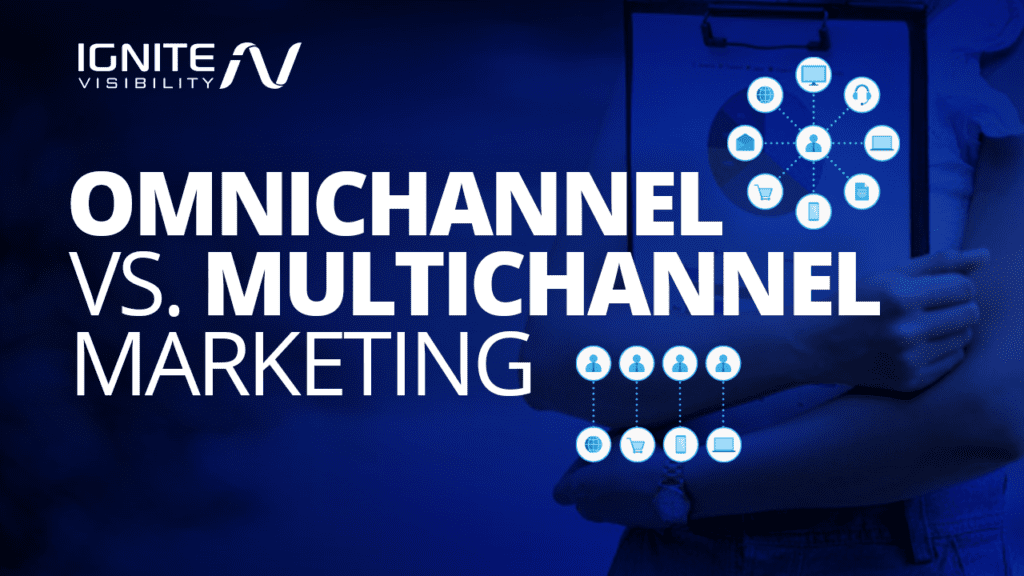If you’ve been paying attention to digital marketing trends, you may have noticed that at some point, people stopped talking about “multichannel marketing” and swapped it out for another buzzword, “omnichannel.”
There’s a lot of overlap between omnichannel and multichannel marketing, both strategies target customers on more than one channel and seek to increase the chances of reaching your audience. Still, there’s a lot of confusion as to whether there’s a difference between the two, or if it’s just a matter of semantics.
In this post, I’ll explain the difference between both strategies, as well as what’s behind the move from multichannel to omnichannel. I’ll also provide some examples of what each strategy looks like in action to help illustrate key differences.
What You’ll Learn:
- Key differences between omnichannel and multichannel
- How to start with an omnichannel approach
- Multichannel vs omnichannel examples
Omnichannel vs. Multichannel Marketing: Here’s the Basic Breakdown
The difference between omnichannel and multichannel marketing is a subtle one.
Omnichannel marketing is designed to provide customers with a consistent experience across all devices and channels. Here, the focus is on making sure the customer has the best possible experience, regardless of which channel they use to engage with your brand.
Done right, an omnichannel strategy ensures that customers always receive relevant, personalized communications that keep them engaged with your brand.
Multichannel marketing is a strategy that spans several channels, which may include your website, email marketing, social media accounts, and even a physical store.
Multichannel strategies typically treat each channel as its own entity, where strategies are developed in a vacuum. This presents a problem for brands, as customers often receive a disjointed experience, with conflicting information or different branding between channels.
Important Distinctions Between Multichannel & Omnichannel Marketing
Today, people switch between devices and channels without thinking, making purchases, consuming content, and splitting their time between digital and physical interactions.
Salesforce found that 58% of customers say that technology has changed their expectations of how brands interact with them, while MyCustomer has put together a nice visuals of what those new expectations are:
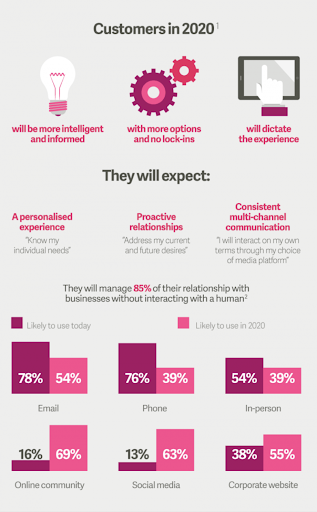
As customers increasingly look toward brands that “know their individual needs,” “address current and future desires,” and enable interactions on customers’ own terms, brands need to align their goals, messaging, and design to those new expectations.
Most brands follow a multichannel model. They might have a blog, a website, and a handful of social media accounts. No matter how well-executed they are, brands leave opportunities on the table when channels don’t work together.
Omnichannel marketing is an extension of multichannel marketing, developed in response to rising customer expectations and evolving technologies.
Here, we’ll go over three core distinctions between omnichannel and multichannel strategies.
Customers over Channels
Multichannel marketing is all about the brand and the channels. Early on, multichannel strategies were adopted in an effort to cater to customers on new platforms.
So, a brick and mortar store might have added a website to reach shoppers online after realizing the potential for more sales. A few years back, companies realized they needed a blog, then a Facebook account, then a YouTube channel, and so on.
In many cases, each new strategy was tacked on to what was there before, and managed in isolation. Each team had their own budgets, processes, and tools, with little contact with other groups.
Today, many brands still work like this. You’ll often see one static message applied across multiple channels, in an effort to create a presence on more social channels. You’ve probably seen this before, companies paste the same exact posts into Instagram, Facebook, LinkedIn, and Twitter without considering customer expectations for each platform.
The problem is, this approach leaves the customer out of the equation, resulting in data silos, fragmented experiences, and different teams working toward different goals.
Omnichannel places the customer at the center of the strategy. While brand messaging is unified across all touchpoints, each channel is adapted to how customers interact with that platform. The challenge here is, making the move from multichannel to omnichannel often requires a complete overhaul of not only strategy, but internal culture.
Consistent Journeys
Here’s the thing about customers: they don’t think about their experience in terms of channel. Their goal is convenience–whether that’s locating information or making a purchase, the goal is to make it easy for customers to do so, regardless of channel.
According to Salesforce’s State of the Connected Customer report, customers are only one bad experience away from churning. Developing a consistent customer journey can help prevent bad experiences from slipping through the cracks, and per a 2014 McKinsey survey is the key to long-term satisfaction.
Consistent journeys begin with the basics: ensuring that policies, rules, and information are the same on every channel.
Another key factor is emotional consistency. In a successful omnichannel strategy, each channel works together to nurture a customer’s connection and establish a sense of trust.
Additionally, omnichannel strategies must work to shape communications around key themes and messages that represent their brand’s values and unique value proposition. Communications should be adapted to reflect the channel, customer segment, and stage in the purchasing journey, however, the key message should remain the same.
It helps to think about this in the same way that you think about yourself as a person. So, you have a certain set of personality traits, essential values, and personal preferences.
These things remain the same, though you’ll shape your behavior to match different situations. A job interview requires a different approach than a first date–both situations are an introduction to your values/personality, but you’re speaking to different segments.
Where multichannel strategies might apply the same message to the date and the interview, omnichannel adjusts based on contextual clues.
As such, an omnichannel strategy looks at how their brand “acts” based on the channel and the relationship with the customer.
How does their message look on LinkedIn vs. Instagram, from one buyer group to the next? How does the message change as the relationship develops?
Coordination Between Channels
Another key difference between multichannel and omnichannel marketing is the relationship between channels.
With multichannel, each channel typically operates according to its own strategy, making it difficult to understand how the customer journey plays out across all of the various touchpoints and platforms in the mix.
To provide a seamless experience, all channels must be connected behind-the-scenes. For example, if you sell products in person, on social media, and online, you’ll need to sync inventory between each of these channels, ensuring customers know which products are available when they try to make a purchase.
That connection also allows brands to develop a sense of which products or messaging performs best on each channel, allowing them to shape the customer experience based on insights collected at multiple touchpoints.
Developing an Omnichannel Approach
Most experts are on the same page when it comes to the omnichannel vs. multichannel debate: omnichannel wins by a long shot.
The main reason many companies still operate in a multichannel world is because it’s challenging, costly, and often requires reimagining your internal operations. To pull off a successful strategy, there are a few key areas that need to be addressed before you can start reaping the advantages of omnichannel.
Rethink Your Organizational Structure
Omnichannel strategies can only work when there’s a high level of collaboration between teams. Everyone from the customer service team and tech support to sales, marketing, HR, and the C-suite need to get on the same page.
Get to Know Your Customer
According to a study by Harvard Business Review, omnichannel customers are more valuable to brands. They spend 4% more per transaction on average, spend 10% more when they shop online compared to their single-channel counterparts.
What’s more, the more channels a brand includes in their strategy, the better the results. That said, it’s not just adding channels that makes this strategy work.
The first thing that needs to happen is, you’ll need to get to know your audience extremely well. What are their needs, preferences, pain points, and goals? How do they communicate–both in terms of tone and channel?
To find out what makes your audience tick, you’ll need to compile information from a wide range of sources. Interview your best customers to learn more about their habits away from your website–what would they like to see from your brand on other channels?
How could you make life easier on them? Solicit feedback from on-site surveys that collect information at specific touchpoints–think checkout pages or support desks.
Dig into your analytics to learn where your referral traffic is coming from and how users behave on your webpages.
Use social listening tools to gauge brand sentiment and uncover what conversations are happening within your niche. Who’s tagging your competitors? Which content gets the most shares?
Develop a Connected System
Developing an omnichannel strategy is to move away from this idea that it’s enough to simply have a presence on as many platforms as possible.
Instead, the goal is to ensure a consistent experience by connecting existing systems so that everyone from the customer service rep to the marketing team to the retail sales rep has the same information at their disposal.
According to a report from the CMO Council, an organization’s relationship with data is directly connected to their ability to understand their audience and deliver the experiences they are looking for.
As brands begin to consider how they’ll move from a multichannel strategy to a connected omnichannel approach, they’ll need to create a connected system that will help them answer the following questions:
- Which customer segments do we serve?
- What does the buyer’s journey look like for each segment?
- What are all of the potential touchpoints that each segment might encounter during the buying process?
- Which channels do customers use? Where do they hang out online?
- How can we capture and connect customer actions as they move between channels?
- What tools will we need to get a real-time view of customer engagement, feedback, revenues, transactions, etc.?
- How can we better identify friction points and their impact on things like poor reviews, cart abandonments, or low engagement?
- What about quantifying the impact of issues on customer satisfaction, retention, and revenues?
- Do our analytics reveal what’s working or not? Do they make it easy to identify the problem and take action? How will those insights be routed to the appropriate team?
For omnichannel to work, everything from CRMs to e-commerce platforms, inventory management software, social media engagement, marketing analytics, need to work together seamlessly.
The goal is to be able to identify patterns that say, tie Instagram Stories to revenue, your new onboarding program to customer retention, or how developing a consistent voice across all channels has increased brand awareness.
Multichannel vs. Omnichannel Examples
Examples of multichannel marketing strategies span a wide range of campaigns, including things like:
Promoting a Twitter hashtag in a TV commercial like Audi has done below:

Another example comes from Leesa. In this case, the mattress brand used a popup email to promote a discount to first-time buyers. So, here, you might have referring sources like Facebook or Google Ads working with the main website and email marketing:

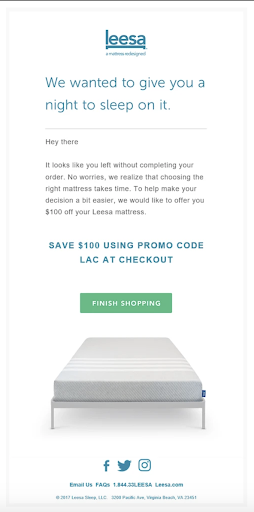
Omnichannel campaigns reflect tight coordination between channels. For example, Campaign Monitor’s social media pages use the same branding elements on each channel, which helps drive brand recognition and maintains
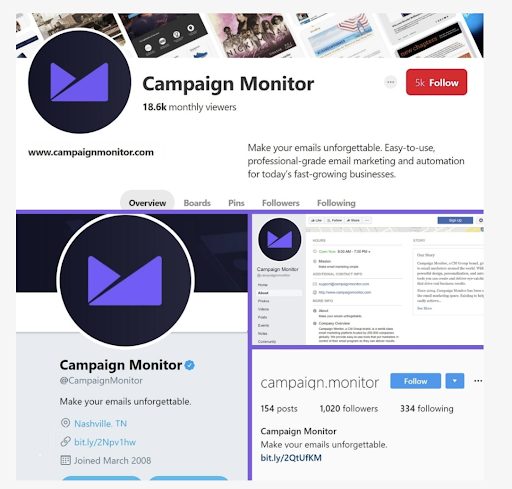
Walgreens offers a great example of maintaining a consistent experience across different devices and service departments. Users can manage their prescriptions, rewards, and upload photos for printing from both the mobile app and the main website.

Another example comes from Crate and Barrel, which has brought the online shopping experience into the retail store. Shoppers can using tablets found throughout the store to scan items, read reviews, and add products to “mobile tote bags.”
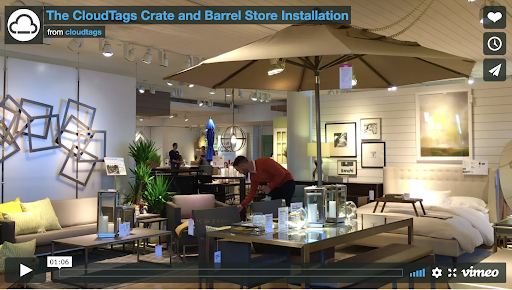
Wrapping Up
The differences between omnichannel and multichannel marketing strategies are subtle but important.
While both strategies focus on reaching customers on multiple channels, companies that invest in an integrated omnichannel approach will have the competitive edge–particularly as more channels and devices enter the fold in the near future.
